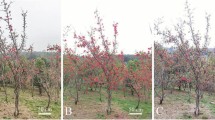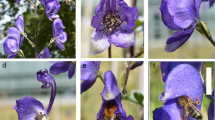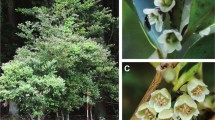An orchid that flowers in harsh conditions pollinates itself unassisted by any of the usual agents.
Abstract
Mating in flowering plants normally relies on animals, wind, gravity or secretion to convey pollen grains from the male (anther) to the female (stigma) organ1,2. Here we describe a new type of self-pollination mechanism in the tree-living orchid Holcoglossum amesianum, in which the bisexual flower turns its anther against gravity through 360° in order to insert pollen into its own stigma cavity — without the aid of any pollinating agent or medium. This mode of self-pollination, which occurs under windless, drought conditions when insects are scarce, adds to the variety of mechanisms that have evolved in angiosperms3,4 to ensure their reproductive success1,5.
This is a preview of subscription content, access via your institution
Access options
Subscribe to this journal
Receive 51 print issues and online access
$199.00 per year
only $3.90 per issue
Buy this article
- Purchase on Springer Link
- Instant access to full article PDF
Prices may be subject to local taxes which are calculated during checkout

Similar content being viewed by others
References
Wang, Y. Q., Zhang, D. X., Renner, S. S. & Chen, Z. Y. Nature 431, 39–40 (2004).
Darwin, C. The Various Contrivances by which Orchids are Fertilised by Insects 2nd edn (Murray, London, 1890).
Stebbins, G. L. Am. Nat. 91, 337–354 (1957).
Piper, J. G., Charlesworth, B. & Charlesworth, D. Nature 310, 50–51 (1984).
Barrett, S. C. H. Nature Rev. Genet. 3, 274–284 (2002).
Seidenfaden, G. Opera Bot. 114, 441–444 (1992).
Herlihy, C. R. & Eckert, C. G. Nature 416, 320–323 (2002).
Holsinger, K. E. Proc. Natl Acad. Sci. USA 97, 7037–7042 (2000).
Dole, J. A. Am. J. Bot. 79, 650–659 (1992).
Lord, E. M. Bot. Rev. 47, 421–449 (1981).
Goodwillie, C., Kalisz, S. & Eckert, C. G. Annu. Rev. Ecol. Evol. Syst. 36, 47–79 (2005).
Author information
Authors and Affiliations
Corresponding author
Ethics declarations
Competing interests
The authors declare no competing financial interests.
Supplementary information
Rights and permissions
About this article
Cite this article
Liu, KW., Liu, ZJ., Huang, L. et al. Self-fertilization strategy in an orchid. Nature 441, 945–946 (2006). https://doi.org/10.1038/441945a
Received:
Accepted:
Published:
Issue Date:
DOI: https://doi.org/10.1038/441945a
This article is cited by
-
Loss of fungal symbionts and changes in pollinator availability caused by climate change will affect the distribution and survival chances of myco-heterotrophic orchid species
Scientific Reports (2023)
-
Stamen curvature and temporal flower closure assure reproductive success in an early-spring-flowering perennial in the cold desert of Middle Asia
Journal of Plant Research (2023)
-
Deforestation Impacts on Diversity of Orchids with Inference on the Conservation Initiatives: Malaysia Case Study
The Botanical Review (2023)
-
A primary study of breeding system of Ziziphus jujuba var. spinosa
Scientific Reports (2021)
-
Spontaneous caudicle reconfiguration in Dactylorhiza fuchsii: A new self-pollination mechanism for Orchideae
Plant Systematics and Evolution (2019)
Comments
By submitting a comment you agree to abide by our Terms and Community Guidelines. If you find something abusive or that does not comply with our terms or guidelines please flag it as inappropriate.



